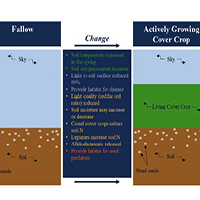Cover crops as a weed seed bank management tool: A soil down review

Accepted: 21 September 2021
HTML: 50
All claims expressed in this article are solely those of the authors and do not necessarily represent those of their affiliated organizations, or those of the publisher, the editors and the reviewers. Any product that may be evaluated in this article or claim that may be made by its manufacturer is not guaranteed or endorsed by the publisher.
This review explores ways that cover crops alter soil environmental conditions that can be used to decrease seed survival, maintain weed seed dormancy, and reduce germination cues, thus reducing above-ground weed pressures. Cover crops are grown between cash crops in rotation, and their residues persist into subsequent crops, impacting weed seeds both during and after cover crops’ growth. Compared to no cover crop, cover crops may reduce weed seedling recruitment and density via: i) reducing soil temperature and fluctuations thereof; ii) reducing light availability and altering light quality; and iii) trapping nitrogen in the cover crop, thus making it less soil-available to weeds. In addition, cover crops may provide habitat for above- and below-ground fauna, resulting in increased weed seed predation. The allelopathic nature of some cover crops can also suppress weeds. However, not all effects of cover crops discourage weeds, such as potentially increasing soil oxygen. Furthermore, cover crops can reduce soil moisture while actively growing but conserve soil moisture after termination, resulting in time-dependent effects. Similarly, decaying legume cover crops can release nitrogen into the soil, potentially aiding weeds. The multiplicity of cover crop species and mixtures, differing responses between weed species, environmental conditions, and other factors hampers uniform recommendations and complicates management for producers. But, cover crops that are managed to maximize biomass, do not increase soil nitrogen, and are terminated at or after cash crop planting will have the greatest potential to attenuate the weed seed bank. There are still many questions to be answered, such as if targeting management efforts at the weed seed bank level is agronomically worthwhile. Future research on cover crops and weed management should include measurements of soil seed banks, including dormancy status, predation levels, and germination.
Highlights
- Cover crops alter the weed seed bank environment, influencing survival, dormancy, and germination.
- Weed seed germination may be reduced by decreased temperature and fluctuations thereof, light, and soil nitrogen.
- Weed seed germination may be increased by greater soil moisture, soil nitrogen, and oxygen.
- Management should maximize cover crop biomass, decrease soil nitrogen, and delay termination for the greatest potential.
- Future research should include measurements of weed seed banks, including dormancy status, predation, and germination.
How to Cite

This work is licensed under a Creative Commons Attribution-NonCommercial 4.0 International License.
PAGEPress has chosen to apply the Creative Commons Attribution NonCommercial 4.0 International License (CC BY-NC 4.0) to all manuscripts to be published.

 https://doi.org/10.4081/ija.2021.1852
https://doi.org/10.4081/ija.2021.1852







